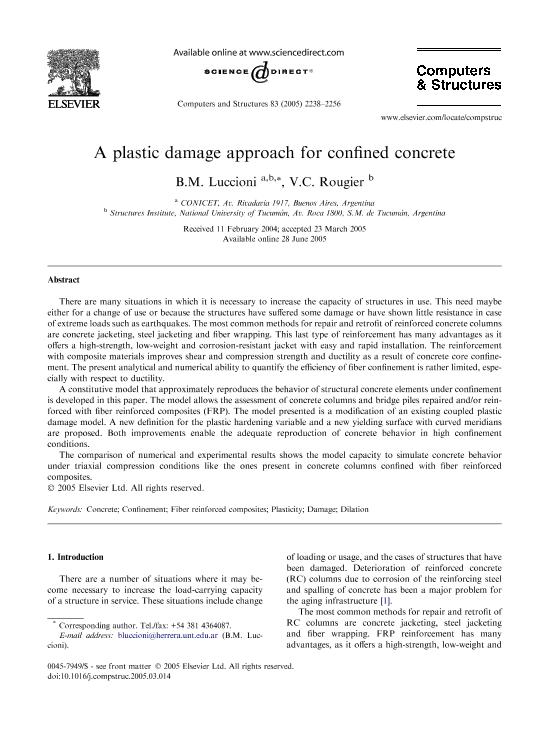Mostrar el registro sencillo del ítem
dc.contributor.author
Luccioni, Bibiana Maria

dc.contributor.author
Rougier, Viviana Carolina

dc.date.available
2020-03-13T15:22:17Z
dc.date.issued
2005-10
dc.identifier.citation
Luccioni, Bibiana Maria; Rougier, Viviana Carolina; A plastic damage approach for confined concrete; Pergamon-Elsevier Science Ltd; Computers & Structures; 83; 27; 10-2005; 2238-2256
dc.identifier.issn
0045-7949
dc.identifier.uri
http://hdl.handle.net/11336/99480
dc.description.abstract
There are many situations in which it is necessary to increase the capacity of structures in use. This need maybe either for a change of use or because the structures have suffered some damage or have shown little resistance in case of extreme loads such as earthquakes. The most common methods for repair and retrofit of reinforced concrete columns are concrete jacketing, steel jacketing and fiber wrapping. This last type of reinforcement has many advantages as it offers a high-strength, low-weight and corrosion-resistant jacket with easy and rapid installation. The reinforcement with composite materials improves shear and compression strength and ductility as a result of concrete core confinement. The present analytical and numerical ability to quantify the efficiency of fiber confinement is rather limited, especially with respect to ductility. A constitutive model that approximately reproduces the behavior of structural concrete elements under confinement is developed in this paper. The model allows the assessment of concrete columns and bridge piles repaired and/or reinforced with fiber reinforced composites (FRP). The model presented is a modification of an existing coupled plastic damage model. A new definition for the plastic hardening variable and a new yielding surface with curved meridians are proposed. Both improvements enable the adequate reproduction of concrete behavior in high confinement conditions. The comparison of numerical and experimental results shows the model capacity to simulate concrete behavior under triaxial compression conditions like the ones present in concrete columns confined with fiber reinforced composites. © 2005 Elsevier Ltd. All rights reserved.
dc.format
application/pdf
dc.language.iso
eng
dc.publisher
Pergamon-Elsevier Science Ltd

dc.rights
info:eu-repo/semantics/openAccess
dc.rights.uri
https://creativecommons.org/licenses/by-nc-sa/2.5/ar/
dc.subject
CONCRETE
dc.subject
CONFINEMENT
dc.subject
DAMAGE
dc.subject
DILATION
dc.subject
FIBER REINFORCED COMPOSITES
dc.subject
PLASTICITY
dc.subject.classification
Ingeniería Civil

dc.subject.classification
Ingeniería Civil

dc.subject.classification
INGENIERÍAS Y TECNOLOGÍAS

dc.title
A plastic damage approach for confined concrete
dc.type
info:eu-repo/semantics/article
dc.type
info:ar-repo/semantics/artículo
dc.type
info:eu-repo/semantics/publishedVersion
dc.date.updated
2020-03-11T18:35:49Z
dc.journal.volume
83
dc.journal.number
27
dc.journal.pagination
2238-2256
dc.journal.pais
Estados Unidos

dc.journal.ciudad
Oxford
dc.description.fil
Fil: Luccioni, Bibiana Maria. Consejo Nacional de Investigaciones Científicas y Técnicas. Centro Científico Tecnológico Conicet - Tucumán; Argentina. Universidad Nacional de Tucumán. Facultad de Ciencias Exactas y Tecnología. Instituto de Estructuras "Ing. Arturo M. Guzmán"; Argentina
dc.description.fil
Fil: Rougier, Viviana Carolina. Universidad Nacional de Tucumán. Facultad de Ciencias Exactas y Tecnología. Instituto de Estructuras "Ing. Arturo M. Guzmán"; Argentina
dc.journal.title
Computers & Structures

dc.relation.alternativeid
info:eu-repo/semantics/altIdentifier/doi/https://dx.doi.org/10.1016/j.compstruc.2005.03.014
dc.relation.alternativeid
info:eu-repo/semantics/altIdentifier/url/https://www.sciencedirect.com/science/article/pii/S0045794905001938?via%3Dihub
Archivos asociados
